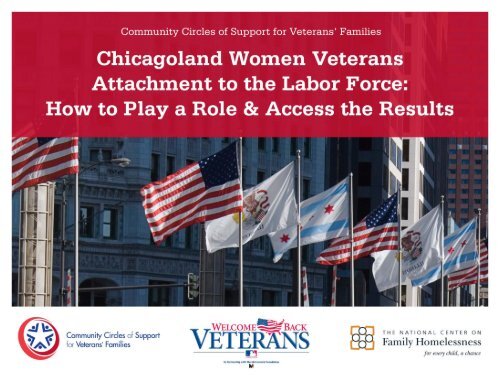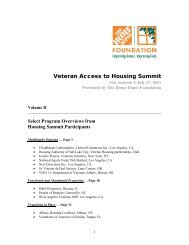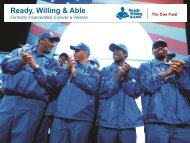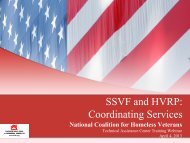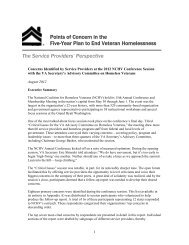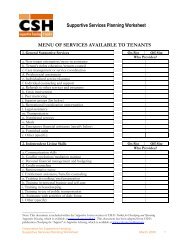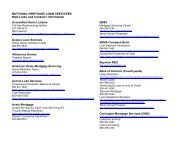Presentation - National Coalition for Homeless Veterans
Presentation - National Coalition for Homeless Veterans
Presentation - National Coalition for Homeless Veterans
Create successful ePaper yourself
Turn your PDF publications into a flip-book with our unique Google optimized e-Paper software.
Overcoming Outreach &<br />
Employment Barriers <strong>for</strong> Women<br />
<strong>Veterans</strong><br />
New Research Strategies
Genesis of Research<br />
Despite higher levels of educational attainment on average,<br />
Women <strong>Veterans</strong> in Chicago & Nationwide:<br />
•Lag male <strong>Veterans</strong> and female civilian counterparts in their<br />
employment rates<br />
•Lag male <strong>Veterans</strong> and female civilian counterparts in their<br />
wage attainment<br />
•These gaps are more pronounced <strong>for</strong> the youngest age<br />
cohort of women <strong>Veterans</strong> aged 18 - 24
Possible Barriers to Women<br />
Veteran Job Readiness,<br />
Employment & Retention<br />
• Women <strong>Veterans</strong> use fewer government benefits<br />
• Less likely to self-identify as <strong>Veterans</strong><br />
• 11% of Military single parents are female as compared to<br />
3% who are male – extrapolate to Veteran population<br />
• More support needs to overcome barriers to employment<br />
such as child care, after-school care and transportation
Possible Barriers to Women<br />
Veteran Job Readiness,<br />
Employment & Retention<br />
• Greater stigma regarding their military service and lack of<br />
recognition <strong>for</strong> their service;<br />
• Wage gaps in civilian employment relative to men;<br />
• Higher rates of Military Sexual Trauma, as well as trauma<br />
experienced prior to their military service, which can<br />
cause co-morbidities that negatively impact job readiness.<br />
• Non-traditional Military work assignments: transportation,<br />
vehicle/air craft maintenance which may be more<br />
challenging to map to civilian employment
Demographic Trends Add<br />
Urgency<br />
According to the U.S. Department of <strong>Veterans</strong> Affairs (VA)<br />
estimates, the number of women <strong>Veterans</strong> will grow from 1.8<br />
million (7.8% of all <strong>Veterans</strong>) in 2010 to 2.13 million<br />
(15%) in 2036.<br />
Women <strong>Veterans</strong> are more likely to . . .<br />
be younger<br />
(median age 47 <strong>for</strong> females 61 <strong>for</strong> males)<br />
identify themselves as a racial minority<br />
Women <strong>Veterans</strong> are up to four times more likely to be<br />
homeless than non-Veteran women. (Foster, 2010)
Women <strong>Veterans</strong> comprise 5% of nation’s<br />
homeless Veteran population.<br />
Of the estimated 107,000 currently homeless<br />
<strong>Veterans</strong>, 7,000 are female. 23% of these<br />
women have children under the age of 18.<br />
(United States Department of <strong>Veterans</strong> Affairs; U.S. Dept. of <strong>Veterans</strong> Affairs<br />
Center <strong>for</strong> Women <strong>Veterans</strong>, 2010; Mulhall, 2009)
Women <strong>Veterans</strong> with children (also single male<br />
<strong>Veterans</strong> with children) are the most underserved<br />
portion of this population.<br />
There is a severe lack of shelters or programs that will<br />
take women with children. The possibility of a woman<br />
losing her children is a real fear.
A number of factors contribute to experiences<br />
of homelessness including:<br />
Economic conditions - Job market, cost of living<br />
Education<br />
Willingness to re-train or move to find work<br />
Isolation and loss of support systems<br />
Challenges that include mental health issues and/or substance abuse<br />
and experiences of violence<br />
Housing and Food Insecurity
Goals of Women <strong>Veterans</strong><br />
Employment Study<br />
• Compare male and female Veteran unemployment and<br />
underemployment,<br />
• understand the dynamics of homelessness among<br />
unemployed female <strong>Veterans</strong>,<br />
• and explore effective service interventions <strong>for</strong> women<br />
<strong>Veterans</strong>.
Women <strong>Veterans</strong> Employment<br />
Study Research Components<br />
Institution Review Board Approved In<strong>for</strong>med Human Consent<br />
Qualitative Research Study comprised of:<br />
•One on One Interviews with Women <strong>Veterans</strong>, including<br />
Women <strong>Veterans</strong> currently experiencing homelessness who<br />
are employed or seeking employment,<br />
•Focus Groups with <strong>Veterans</strong> who are employed or seeking<br />
employment,<br />
•Focus Groups with Employers and Community Stakeholders
Outreach Methods & Techniques<br />
• Use “Tear off” Flyers <strong>for</strong> hard copy postings on bulletin<br />
boards on campuses; federal, state, county or municipal<br />
benefits or employment offices, faith based or other<br />
community groups (Avoid “Static” Posters)<br />
• Electronic versions of Flyers have “live link” <strong>for</strong> e-<br />
mail/websites<br />
• Pay attention to language i.e., suspicion of the word “Free”<br />
try “No Cost To You”
Outreach Methods & Techniques<br />
• Offer “on-site” child care<br />
• Offer lists of resources<br />
• Provide stipends (but don’t use that word) <strong>for</strong><br />
transportation & separate stipends <strong>for</strong> participation<br />
• In an In<strong>for</strong>med Human Consent Research Study strict parameters are<br />
established so that stipends are not cohesive and the value of<br />
stipends must be pre-approved<br />
• The purpose of stipends is to recognize the ef<strong>for</strong>t required to<br />
participate and to make the participant feel valued<br />
• Stipends may be cash or desired gift cards – bus/train passes, food<br />
or other retail outlets
Outreach Methods & Techniques<br />
• Relationship, Relationship, Relationship with Referral<br />
Sources – don’t presume & do things your referrers way<br />
• Shoe Leather – Show up to events & the value of walking<br />
in the door at places that may not on surface seem like the<br />
place to go<br />
• If you don’t ask, nothing happens<br />
• Ensuring that your “ask” is appropriate<br />
• Keeping Referral Sources in “the loop”<br />
• Within the bounds of confidentiality, providing outcome feed<br />
back<br />
• Interim & Final Briefings: In-person and electronic
See Separate Attachments <strong>for</strong><br />
Samples of Outreach Materials


